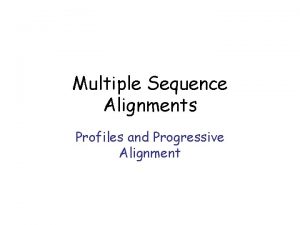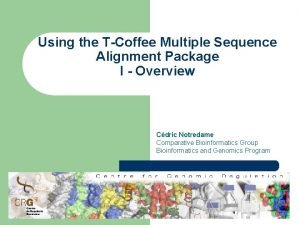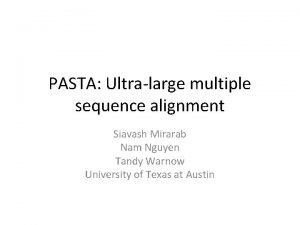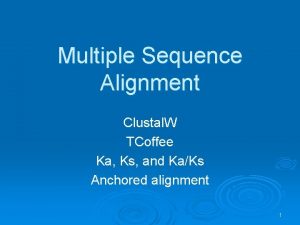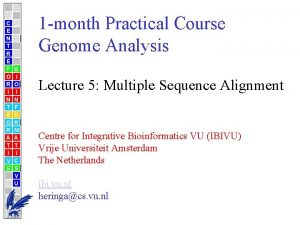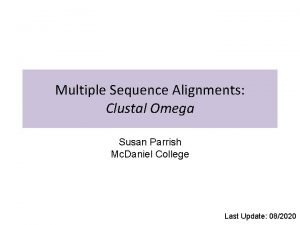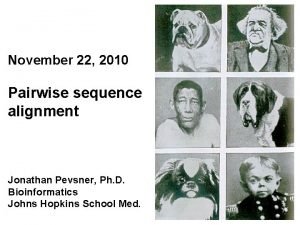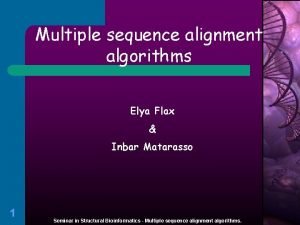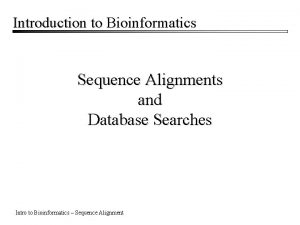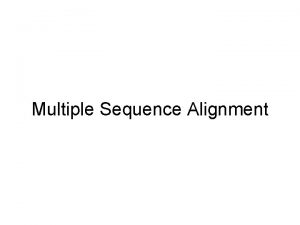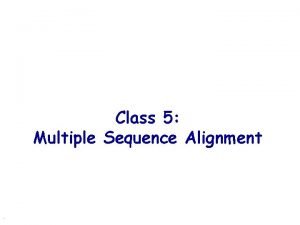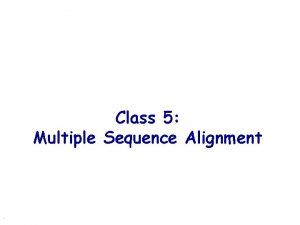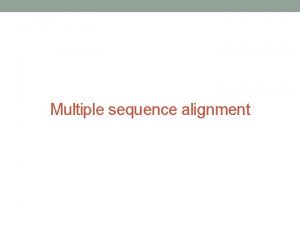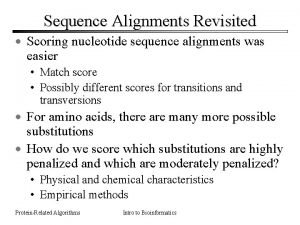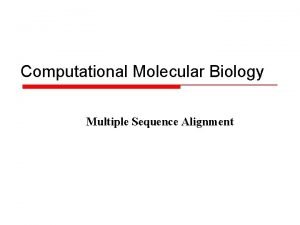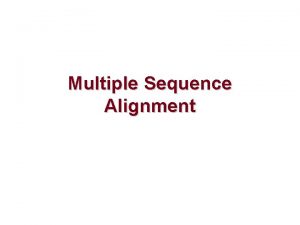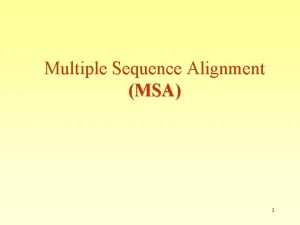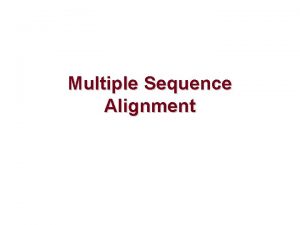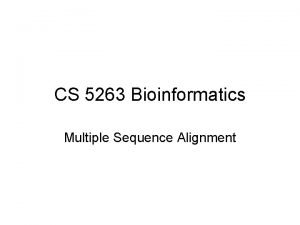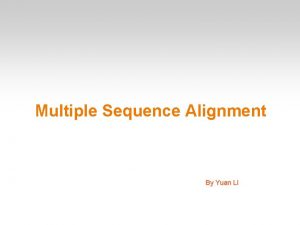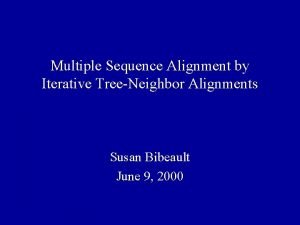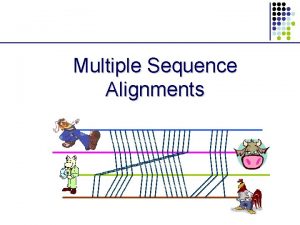Multiple Sequence Alignments Profiles and Progressive Alignment Profiles





















- Slides: 21

Multiple Sequence Alignments Profiles and Progressive Alignment

Profiles for families of sequences can be built from MSAs 1 1 2 3 C G A A 2 3 A 50% 75% 25% — C 25% A T T 0% A A G 0% 25% — A — — 25% 0% 0% 0% 25% 0% 0% 50% Note: While profiles can be used for any kind of sequence data, we’ll focus on protein sequences

Profiles • Profile: A table that lists the frequencies of each amino acid in each position of protein sequence. • Frequencies are calculated from a MSA containing a domain of interest • Allows us to identify consensus sequence • Derived scoring scheme allows us to align a new sequence to the profile – Profile can be used in database searches – Find new sequences that match the profile • Profiles also used to compute multiple alignments heuristically – Progressive alignment

Profiles: Position-Specific Scoring Matrix (PSSM) • To compare a sequence to a profile, need to assign a score for each amino acid • The score the profile for amino acid a at position p is where – f(p, b) = frequency of amino acid b in position p – s(a, b) is the score of (a, b) (from, e. g. , BLOSUM or PAM)

Profiles: PSSM Insertion/deletion penalty Gribskov et al. PNAS. 84 (13): 4355 (1987)

Profiles: Consensus Sequence • A consensus residue C(p) is generated at each position of the profile to aid the display of alignments of target sequences with the profile. • The consensus residue c is the amino acid at p that has the highest score M(p, c). – c is the amino acid most mutationally similar to all the aligned residues of the probe sequences at p, rather than the most common one

Aligning a sequence to a profile K K K M L L M K M – – L L L New sequence: K K L L K K – M 1 2 3 4 5 K. 75. 25. 75 L. 75 M. 25. 50. 25. 25 M Align with profile: K K L - L M 1 - 2 3 4 5 K K M K - L L L M K M – L L L M K K – M

Scoring a sequence-to-profile alignment • Score each column separately according to PSSM • Each character contributes to score, weighed by its frequency 1 2 3 4 5 K. 75. 25. 75 L. 75 M. 25. 50. 25 - . 25. 25 K 1 K - L 2 3 L 4 M 5 Column 1 score: 0. 75 s(K, K) + 0. 25 s(K, M)

Profile-to-sequence alignments • Optimum alignment can be found by dynamic programming – Extension of Needleman-Wunsch • Spaces are only added to msa – never removed – Once a gap, always a gap • Can align profiles to profiles

Evolutionary Profiles • Profiles just seen are called average profiles • Generally perform well, but disregard some of the biology – How did each position evolve? – Amount of conservation varies from position to position – Type of conservation varies from position to position • Alternative: Evolutionary profiles – Gribskov, M. and Veretnik, S. , Methods in Enzymology 266, 198 -212, 1996

Evolutionary Profiles • Idea: Fit a different model at each position • For each position i : – For each possible ancestor b for position i • Try various evolutionary distances x (assume PAM model), and choose the one that minimizes cross entropy where – fa = observed frequency of a – pa= predicted frequency of a assuming b is the ancestor and x is the distance • This generates 20 distributions for position i

Evolutionary Profiles • For each position i – Compute “mixture coefficient, ” Wai, measuring likelihood that the residue a generated observed distribution (see text) – Profile is given by where • paij = frequency of residue j in the ancestral residue distribution a at position i • prandom j = frequency of residue j in the database

Progressive multiple alignment • Feng & Doolittle 1987, Higgins and Sharp 1988 • Idea: Sequences to be aligned are phylogenetically related – these relationships are used to guide the alignment • Popular implementations: CLUSTALW, PILEUP, T-Coffee

CLUSTALW 1. Perform pair-wise alignments between all pairs of sequences (n x (n-1)/2 possibilities) 2. Generate distance matrix. • Distance between a pair = number of mismatched positions in alignment divided by total number of matched positions 3. Generate a Neighbor-Joining ‘guide tree’ from distance table 4. Use guide tree to progressively align sequences in pairs from tips to root of tree. • • Actually, align profiles “Once a gap, always a gap”

CLUSTALW

CLUSTALW Tree calculated from an alignment of more than 1100 ring finger domains, using Clustal. W 1. 83.

CLUSTALW heuristics 1. Individual weights are assigned to each sequence in a partial alignment in order to downweight similar sequences and up-weight highly divergent ones. 2. Varying substitution matrices at different alignment stages according to sequence divergence. 3. Gaps • Positions in early alignments where gaps have been opened receive locally reduced gap penalties • Residue-specific gap penalties and locally reduced gap penalties in hydrophilic regions encourage new gaps in potential loop regions rather than regular secondary structure.

Progressive Alignment: Discussion • Strengths: – Speed – Progression biologically sensible (aligns using a tree) • Weaknesses: – No objective function. – No way of quantifying whether or not the alignment is good

Problems with CLUSTALW • Local minimum problem: – Alignment depends on sequence addition order. – With each alignment some proportion of residues are misaligned • Worse for divergent sequences – Errors get “locked in” and propagate as sequences are added – Can result in arbitrary and incorrect alignments • Clustal uses global alignment … may not be accurate for all parts of the sequence – T-Coffee considers local similarity as well as global

Iterative alignment • To avoid local minima, realign subgroups of sequences and then incorporate them into a growing multiple sequence alignment – Improves overall alignment score. – May involve rebuilding the guide tree – May be randomized • Programs: – Mult. Alin – PRRP – DIALIGN

Phylogenetic Alignment Given a tree for a set of species S, find ancestral species such that total distance is minimized. GTGG CTGG GTGG CCGG CTAA GTAA CTTC
 Progressive multiple sequence alignment
Progressive multiple sequence alignment Tcoffee multiple sequence alignment
Tcoffee multiple sequence alignment Pasta multiple sequence alignment
Pasta multiple sequence alignment Tcoffee multiple sequence alignment
Tcoffee multiple sequence alignment A named sequence of statements is known as
A named sequence of statements is known as Praline multiple sequence alignment
Praline multiple sequence alignment Dodaf
Dodaf Local and global alignment
Local and global alignment Global alignment example
Global alignment example Difference between local and global alignment
Difference between local and global alignment Sequence alignment
Sequence alignment Jonathan pevsner
Jonathan pevsner Past perfect functions
Past perfect functions Bioedit
Bioedit Dot plot bioinformatics example
Dot plot bioinformatics example Cluster omega
Cluster omega Sequence alignment
Sequence alignment Sequence alignment
Sequence alignment Hirschberg's algorithm
Hirschberg's algorithm What is gap penalty in bioinformatics
What is gap penalty in bioinformatics Present progressive passive
Present progressive passive Simple past and progressive
Simple past and progressive
